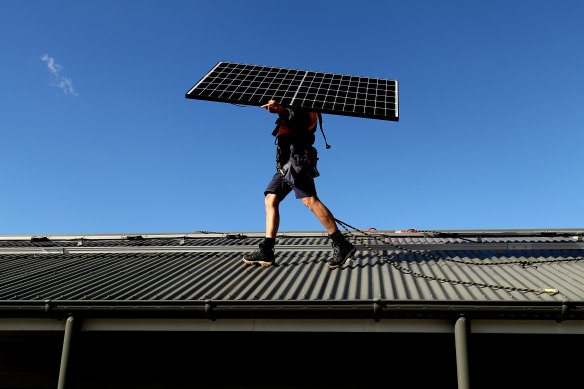- Exclusive
- National
- WA
- WA residential property
The ‘quick-fix’ renovations that could save WA home owners (and the government) big on power bills
Targeted state government grants to help West Australians undertake quick fix upgrades to their home could save residents thousands on their power bills, and reduce peak demand in summer and the need for expensive network upgrades.
Exclusive data from the Climateworks Centre revealed how existing homes in each state and territory could be renovated in line with the federal government’s chosen ratings to bring them up to the same standards as a new efficient home, along with the bill savings for each type of renovation.

New research has identified renovation projects that could save home owners big on power bills – and help the government manage skyrocketing power demand.Credit: Brendon Thorne
Researchers examined three different upgrade levels and the average costs, from quick-fix solutions like ceiling insulation, draught sealing, heavy drapes and roller shutters with an average cost of $15,000, to climate-ready upgrades such as floor and wall insulation and double-glazed windows at an average cost of $40,000.
They found “quick-fix” upgrades could reduce the emissions from powering a home by the equivalent of one tonne of carbon dioxide, while electrified appliances resulted in a reduction of 0.7 tonnes.
Research lead Gill Armstrong said climate-ready upgrades to low-performing detached houses could dramatically reduce peak energy demand, particularly in WA, which had cooler and longer winters.
She said without addressing this issue, Australia risked overspending on energy grid transmission upgrades.
“Inefficient home design with gaps around windows and doors, and between building materials, allows outside air to leak in and out of homes,” she said.
“It causes people to turn their heaters up in winter and air conditioning up in summer, resulting in expensive energy bills.”
Quick-fix and climate-ready thermal upgrades would reduce annual peak demand by 1.4–3.5 kilowatts per home, the equivalent to a 30–77 per cent reduction in peak household demand.
People in low-performing detached houses could save up to $1600 a year by installing thermal upgrades and electrifying their appliances.
A record heatwave last summer that at times saw parts of WA hold the title of hottest place on the planet smashed grid demand levels, with the top six operational demand peaks ever recorded all occurring between January 31 and February 19.
The record for peak demand in the south-west interconnected system was 4233 megawatts, clocked on February 18.
According to Synergy, peak demand on WA’s main electricity system was usually between 5pm and 9pm on the hottest days of the year.
It said climate change was causing more extreme weather conditions and hotter summers, which meant peak demand events were becoming more common.
Synergy predicted WA’s demand for electricity would increase as its population grew, and residents used more air conditioning and electric vehicles.
A report from the Australian Energy Market Operator, released in June, said the power system servicing WA’s south-west was in good shape for the next three years, but foreshadowed massive investment in extra generation and storage capacity needed to replace Collie’s coal-fired power stations.
AEMO predicted a small shortfall this summer, but expected that to be addressed by a tender for additional capacity and the state government’s decision to keep a turbine at Synergy’s Muja power station in reserve for six months after it was planned to be retired.
However, in it predicted a shortfall of generation capacity of almost 400 megawatts in 2027-28, increasing more than sevenfold over the following six years to 2880 megawatts in 2033-34.
Curtin University Associate Professor in Sustainable Energy Systems Liam Wagner said national building efficiency standards needed to be ramped up to make homes cheaper to run in the long term.
He said quick-fix renovations that improved energy efficiency would dampen the growth rate in peak demand from the state’s main grid.
Wagner supported calls for state government energy efficiency rebates for residents living in poor-quality existing housing stock.
“We are moving towards batteries in households so that they can act as a power station, not just for the household, but to be able to dispatch energy into the grid when it’s needed and reduce our reliance on centralised fossil fuel electricity generation,” he said.
Australian Housing and Urban Research Institute studies have found the environmental performance standards of Australian housing are considerably weaker than our international counterparts.
The institute estimated 70 per cent of existing Australian houses had an energy rating of three stars or lower. By 2050, there would still be seven million pre-existing homes that did not meet housing energy standards.
University of South Australia Associate Professor Lyrian Daniel said mandatory approaches were needed to lift the environmental standard of most homes.
“One example is the compulsory disclosure of the home’s energy efficiency of a home at point of sale or lease,” she said.
“The ACT Government’s mandatory disclosure requirement means the territory has the highest level of energy efficiency improvements to existing owner-occupied dwellings.”
WA Greens MLC Brad Pettitt said rebates had been extremely successful for increasing household solar, and now was the time to apply the same approach to household batteries and other energy efficiency measures.
“This would be a far more sustainable and enduring solution than throwing thousands of dollars into electricity credits,” he said.
Last month, it was revealed property owners would be legally required to disclose the energy performance of their home before sale or rent under a new scheme being developed by the federal government.
The state government has commissioned four big batteries with the specific task of capturing excess rooftop solar in the middle of the day and storing it for the evening peak.
Start the day with a summary of the day’s most important and interesting stories, analysis and insights. Sign up for our Morning Edition newsletter.